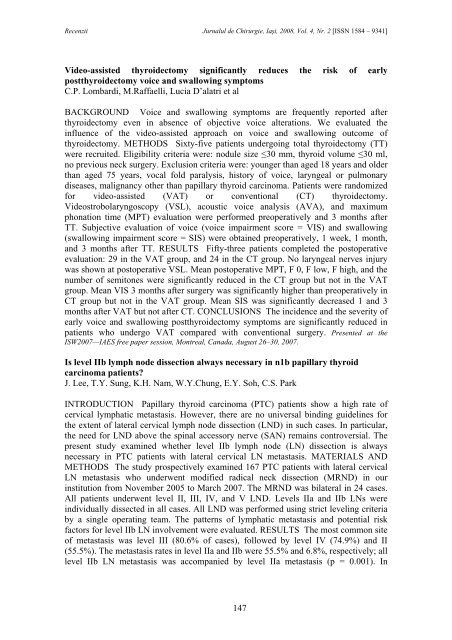Full text PDF (3.9MB) - Jurnalul de Chirurgie
Full text PDF (3.9MB) - Jurnalul de Chirurgie
Full text PDF (3.9MB) - Jurnalul de Chirurgie
You also want an ePaper? Increase the reach of your titles
YUMPU automatically turns print PDFs into web optimized ePapers that Google loves.
Recenzii <strong>Jurnalul</strong> <strong>de</strong> <strong>Chirurgie</strong>, Iaşi, 2008, Vol. 4, Nr. 2 [ISSN 1584 – 9341]<br />
Vi<strong>de</strong>o-assisted thyroi<strong>de</strong>ctomy significantly reduces the risk of early<br />
postthyroi<strong>de</strong>ctomy voice and swallowing symptoms<br />
C.P. Lombardi, M.Raffaelli, Lucia D’alatri et al<br />
BACKGROUND Voice and swallowing symptoms are frequently reported after<br />
thyroi<strong>de</strong>ctomy even in absence of objective voice alterations. We evaluated the<br />
influence of the vi<strong>de</strong>o-assisted approach on voice and swallowing outcome of<br />
thyroi<strong>de</strong>ctomy. METHODS Sixty-five patients un<strong>de</strong>rgoing total thyroi<strong>de</strong>ctomy (TT)<br />
were recruited. Eligibility criteria were: nodule size ≤30 mm, thyroid volume ≤30 ml,<br />
no previous neck surgery. Exclusion criteria were: younger than aged 18 years and ol<strong>de</strong>r<br />
than aged 75 years, vocal fold paralysis, history of voice, laryngeal or pulmonary<br />
diseases, malignancy other than papillary thyroid carcinoma. Patients were randomized<br />
for vi<strong>de</strong>o-assisted (VAT) or conventional (CT) thyroi<strong>de</strong>ctomy.<br />
Vi<strong>de</strong>ostrobolaryngoscopy (VSL), acoustic voice analysis (AVA), and maximum<br />
phonation time (MPT) evaluation were performed preoperatively and 3 months after<br />
TT. Subjective evaluation of voice (voice impairment score = VIS) and swallowing<br />
(swallowing impairment score = SIS) were obtained preoperatively, 1 week, 1 month,<br />
and 3 months after TT. RESULTS Fifty-three patients completed the postoperative<br />
evaluation: 29 in the VAT group, and 24 in the CT group. No laryngeal nerves injury<br />
was shown at postoperative VSL. Mean postoperative MPT, F 0, F low, F high, and the<br />
number of semitones were significantly reduced in the CT group but not in the VAT<br />
group. Mean VIS 3 months after surgery was significantly higher than preoperatively in<br />
CT group but not in the VAT group. Mean SIS was significantly <strong>de</strong>creased 1 and 3<br />
months after VAT but not after CT. CONCLUSIONS The inci<strong>de</strong>nce and the severity of<br />
early voice and swallowing postthyroi<strong>de</strong>ctomy symptoms are significantly reduced in<br />
patients who un<strong>de</strong>rgo VAT compared with conventional surgery. Presented at the<br />
ISW2007—IAES free paper session, Montreal, Canada, August 26–30, 2007.<br />
Is level IIb lymph no<strong>de</strong> dissection always necessary in n1b papillary thyroid<br />
carcinoma patients?<br />
J. Lee, T.Y. Sung, K.H. Nam, W.Y.Chung, E.Y. Soh, C.S. Park<br />
INTRODUCTION Papillary thyroid carcinoma (PTC) patients show a high rate of<br />
cervical lymphatic metastasis. However, there are no universal binding gui<strong>de</strong>lines for<br />
the extent of lateral cervical lymph no<strong>de</strong> dissection (LND) in such cases. In particular,<br />
the need for LND above the spinal accessory nerve (SAN) remains controversial. The<br />
present study examined whether level IIb lymph no<strong>de</strong> (LN) dissection is always<br />
necessary in PTC patients with lateral cervical LN metastasis. MATERIALS AND<br />
METHODS The study prospectively examined 167 PTC patients with lateral cervical<br />
LN metastasis who un<strong>de</strong>rwent modified radical neck dissection (MRND) in our<br />
institution from November 2005 to March 2007. The MRND was bilateral in 24 cases.<br />
All patients un<strong>de</strong>rwent level II, III, IV, and V LND. Levels IIa and IIb LNs were<br />
individually dissected in all cases. All LND was performed using strict leveling criteria<br />
by a single operating team. The patterns of lymphatic metastasis and potential risk<br />
factors for level IIb LN involvement were evaluated. RESULTS The most common site<br />
of metastasis was level III (80.6% of cases), followed by level IV (74.9%) and II<br />
(55.5%). The metastasis rates in level IIa and IIb were 55.5% and 6.8%, respectively; all<br />
level IIb LN metastasis was accompanied by level IIa metastasis (p = 0.001). In<br />
147

















